IMSAI 8080
The IMSAI 8080 was an early microcomputer released in late 1975, based on the Intel 8080 and later 8085 and S-100 bus.[1] It was a clone of its main competitor, the earlier MITS Altair 8800. The IMSAI is largely regarded as the first "clone" microcomputer. The IMSAI machine ran a highly modified version of the CP/M operating system called IMDOS. It was developed, manufactured and sold by IMS Associates, Inc. (later renamed IMSAI Manufacturing Corp). In total, between 17,000 and 20,000 units were produced from 1975 to 1978.
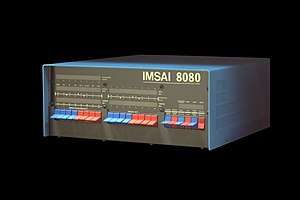 | |
| Manufacturer | IMS Associates, Inc., later IMSAI Manufacturing Corporation |
|---|---|
| Type | Hobbyist computer, aluminum casing, 22-slot motherboard, S-100 bus |
| Release date | December 1975[1] |
| Discontinued | 1978 |
| Operating system | First commercial supplier of Digital Research's CP/M, later followed by derived IMDOS BASIC, FORTRAN |
| CPU | Intel 8080/8085A @ 2 MHz/3 MHz |
| Memory | 256/4K bytes on a 4K board (static), 16K, 32K, 64K DRAM |
| Storage | Optional Compact Cassette or 51⁄4" and 8" floppy drives, hard drives (CDC Hawk— 5 MB fixed, 5 MB removable)[2] |
| Website | www |
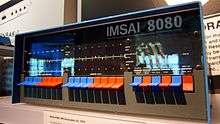
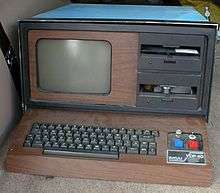
History
In May 1972, William Millard started businesses individually as IMS Associates (IMS) in the areas of computer consulting and engineering, using his home as an office. By 1973, Millard founded IMS Associates, Inc. Millard soon found funding for his business, and received several contracts, all for software.
In 1974, IMS was contacted by a client which wanted a "workstation system" that could complete jobs for any General Motors car dealership. IMS planned a system including a terminal, small computer, printer, and special software. Five of these workstations were to have common access to a hard disk drive, which would be controlled by a small computer. Eventually product development was stopped.
Millard and his chief engineer Joe Killian turned to the microprocessor. Intel had announced the 8080 chip, and compared to the 4004 to which IMS Associates had been first introduced, it looked like a "real computer". Full-scale development of the IMSAI 8080 was put into action using the existing Altair 8800's S-100 bus, and by October 1975 an ad was placed in Popular Electronics, receiving positive reactions.[3]
IMS shipped the first IMSAI 8080 kits on 16 December 1975, before turning to fully assembled units.[4] In 1976, IMS was renamed to IMSAI Manufacturing Corporation because by then, they were a manufacturing company, not a consulting firm.
In 1977, IMSAI marketing director Seymour I. Rubinstein paid Gary Kildall $25,000 for the right to run CP/M version 1.3, which eventually evolved into an operating system called IMDOS, on IMSAI 8080 computers.[5][6][7][8] Other manufacturers followed and CP/M eventually became the de facto standard 8-bit operating system.
By October 1979, the IMSAI corporation was bankrupt. The 'IMSAI' trademark was acquired by Thomas "Todd" Fischer and Nancy Freitas (former early employees of IMS Associates), who continued manufacturing the computers under the IMSAI name as a division of Fischer-Freitas Co. Support for early IMSAI systems continues.[9]
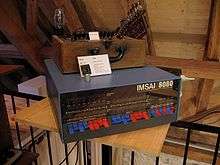
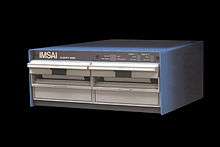
VDP series
In mid-1977 IMSAI released the VDP-series, based on the Intel 8085. According to the product description of January 1978, many different models were released, with 32K or 64K memory and a 9" (VDP4x-range) or 12" (VDP8x-range) video display. For example, the VDP-40 had two 5-1/4" disk drives, a 9" 40-character-wide display and a 2K ROM monitor all in one cabinet. The built-in keyboard had a 8035 microprocessor and a serial interface to the main board. The VIO-C video board had 2K firmware ROM, 2K character generator read-only memory (ROM) with 256 characters and 2K of refresh memory.
The VDP80/1050 was listed in January 1978 for $10,920 and the VDP-40/64 for $7,466.
IMSAI in popular culture
An IMSAI 8080 and an acoustic coupler type modem were among the hacking tools used by the main character in the 1983 movie WarGames.[10]
The 2011 novel Ready Player One by Ernest Cline features an IMSAI 8080 at the end, being the place where Wade "Parzifal" Watts finds the easter egg that will grant control of the OASIS virtual reality to its finder.
Further reading
- THE HISTORY OF IMSAI: The Path to Excellence, produced 1978
- Freiberger, Paul; Swaine, Michael (2000) [1984]. Fire in the Valley: The Making of the Personal Computer (2nd ed.). New York, USA: McGraw-Hill. ISBN 0-07-135892-7.
References
- THE HISTORY OF IMSAI- The Path to Excellence, IMSAI of Fischer-Freitas Company (original text 1978)
- Press Release: IMSAI Announces Hard Disk
- IMS Associates, Inc. (October 1975). "IMASI and Altair Owners". Popular Electronics. Ziff Davis. 8 (4): 110. Advertisement: IMSAI 8080 computer with 1K of RAM. $439 kit, $621 assembled.
- Littman, Jonathan (1987). Once Upon a Time in ComputerLand: The Amazing, Billion-Dollar Tale of Bill Millard. Los Angeles: Price Stern Sloan. p. 18. ISBN 0-89586-502-5. "Later that day, December 16 [1975], United Parcel Service picked up the first shipment of 50 IMS computer kits for delivery to customers."
- Wallace, James; Erickson, Jim (1993). Hard Drive: Bill Gates and the Making of the Microsoft Empire. New York: HarperBusiness. ISBN 0-88730-629-2.
- Kildall, Gary Arlen (January 1980). "The History of CP/M, The Evolution of an Industry: One Person's Viewpoint" (Vol. 5, No. 1, Number 41 ed.). Dr. Dobb's Journal. pp. 6–7. Retrieved 2013-06-03.
[…] The first commercial licensing of CP/M took place in 1975 with contracts between Digital Systems and Omron of America for use in their intelligent terminal, and with Lawrence Livermore Laboratories where CP/M was used to monitor programs in the Octopus network. Little attention was paid to CP/M for about a year. In my spare time, I worked to improve overall facilities […] By this time, CP/M had been adapted for four different controllers. […] In 1976, Glenn Ewing approached me with a problem: Imsai, Incorporated, for whom Glenn consulted, had shipped a large number of disk subsystems with a promise that an operating system would follow. I was somewhat reluctant to adapt CP/M to yet another controller, and thus the notion of a separated Basic I/O System (BIOS) evolved. In principle, the hardware dependent portions of CP/M were concentrated in the BIOS, thus allowing Glenn, or anyone else, to adapt CP/M to the Imsai equipment. Imsai was subsequently licensed to distribute CP/M version 1.3, which eventually evolved into an operating system called IMDOS. […]
- Shustek, Len (2016-08-02). "In His Own Words: Gary Kildall". Remarkable People. Computer History Museum.
- Kildall, Gary Arlen (2016-08-02) [1993]. Kildall, Scott; Kildall, Kristin (eds.). Computer Connections: People, Places, and Events in the Evolution of the Personal Computer Industry (Manuscript, part 1). Kildall Family. Retrieved 2016-11-17.
- "Company: IMS Associates, Inc. (IMSAI)". Computerhistory.org. Retrieved 2008-10-27.
- "The "Wargames IMSAI"". imsai.net. Retrieved December 28, 2017.
External links
| Wikimedia Commons has media related to IMSAI 8080. |
- Distributor of IMSAI parts, docs and the Series Two model www.imsai.net
- Short description of the IMSAI 8080 with photos oldcomputers.net
- The History of the IMSAI 8080 www.pc-history.org
- IMSAI 8080 www.old-computers.com
- IMSAI 8080 oldcomputermuseum.com
- IMSAI 8080 Replica Kit thehighnibble.com
- Marcus Bennett's IMSAI
- "War Games" IMSAI 8080 - Computerphile, YouTube, 28 March 2018